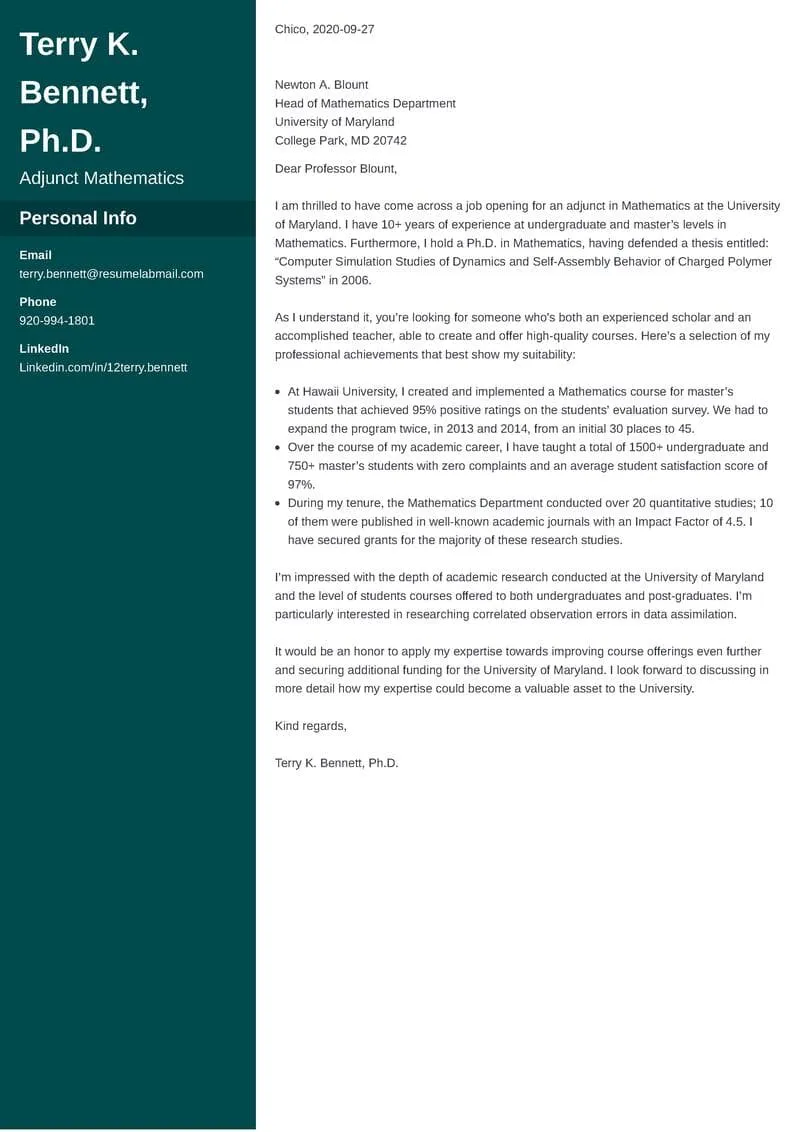Crafting Your Faculty Cover Letter
A faculty cover letter is your initial introduction to a potential employer, playing a pivotal role in securing an interview. It’s more than just a formality; it’s a powerful tool for showcasing your qualifications, research, teaching experience, and overall fit for the position. A well-crafted letter can significantly boost your chances of landing your dream job, setting the stage for a successful academic career. It’s your chance to make a strong first impression and persuade the hiring committee that you are the ideal candidate. Therefore, meticulous attention to detail and a strategic approach are essential for creating an effective faculty cover letter.
Understanding the Purpose of a Faculty Cover Letter
The primary aim of a faculty cover letter is to persuade the hiring committee that you possess the necessary qualifications and are a good fit for the institution and the specific role. It serves as a comprehensive introduction to your professional background, highlighting key achievements, and demonstrating how your skills and experiences align with the job requirements. Unlike a curriculum vitae (CV), which provides a detailed record of your accomplishments, the cover letter allows you to tell a story about your career, illustrating your motivations, goals, and the unique value you bring to the table. It should convey your passion for the field and your eagerness to contribute to the university’s academic mission.
Key Components of a Strong Faculty Cover Letter
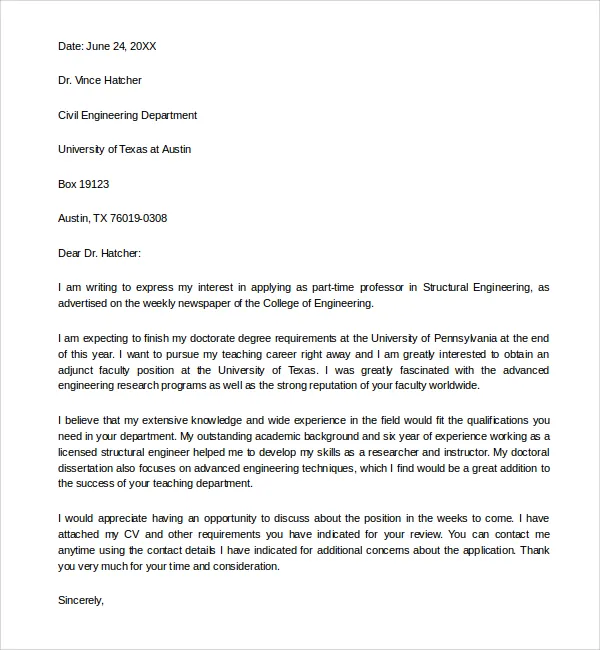
A compelling faculty cover letter comprises several critical components that collectively communicate your suitability for the position. Each section must be carefully crafted to make a lasting impression. The structure is crucial, with a clear and concise format that enables easy reading and comprehension. The content must be tailored to the specific job requirements, highlighting relevant skills and experiences. This section will guide you through the essential elements, from the initial greeting to the final closing, ensuring your application stands out. The key is to create a persuasive narrative that showcases your potential and enthusiasm for the role.
Header and Contact Information
Begin your cover letter with a professional header that includes your full name, contact information (phone number and email address), and the date. This information should be placed at the top left or right of the document. Ensure your contact details are accurate and up-to-date. Using a clear, easy-to-read font, such as Times New Roman or Arial, enhances readability. The header sets a professional tone, making it easy for the hiring committee to contact you. Double-check the accuracy of your contact information before submitting your application. Always make sure that your email address is professional.
Addressing the Hiring Committee
Whenever possible, address your cover letter to a specific individual, such as the search committee chair or the hiring manager. This personal touch demonstrates your attention to detail and genuine interest in the position. If the name is not provided in the job posting, research the department’s website or contact the university to find it. If you are unable to identify a specific person, use a general greeting such as “Dear Search Committee” or “Dear Hiring Committee.” Avoid generic greetings such as “To Whom It May Concern,” which can make your letter seem impersonal. Ensure your greeting reflects professionalism and respect.
Opening Paragraph Capturing Attention

Your opening paragraph is your first chance to grab the reader’s attention and make a strong initial impression. Start with a concise statement that identifies the position you are applying for and where you learned about it. Clearly state your interest in the role and the institution, highlighting what specifically attracts you to both. Briefly mention your key qualifications or the most relevant aspects of your experience. Avoid generic phrases and instead, express genuine enthusiasm for the opportunity. The opening paragraph should set the stage for the rest of your letter, showcasing your excitement and suitability for the role.
Highlighting Your Research and Publications
In the body of your letter, devote a section to your research accomplishments and publications. Provide a brief overview of your research interests and how they align with the department’s focus. Highlight your key publications, emphasizing their significance and impact. If applicable, mention any grants or funding you have received. Demonstrate your ability to contribute to the university’s research goals. Instead of simply listing publications, discuss their relevance to the position and the potential for future research collaboration. Your goal is to demonstrate your scholarly contributions and your potential to become a valuable member of the research community.
Showcasing Your Teaching Experience
If the faculty position involves teaching responsibilities, dedicate a section to showcase your teaching experience. Describe the courses you have taught, the level of students you have worked with, and the teaching methodologies you employ. Emphasize any innovative teaching practices or achievements. Include any positive feedback you have received from students or colleagues. Mention your ability to develop engaging and effective learning environments. Highlight your commitment to student success. Demonstrate your ability to inspire students and effectively convey complex concepts.
Emphasizing Your Skills and Qualifications

Clearly articulate your skills and qualifications that directly align with the job description. Identify the key requirements listed in the job posting and provide specific examples of how your experiences and skills meet those criteria. This may include technical skills, leadership abilities, and relevant software proficiencies. Be specific and provide concrete examples of how you have demonstrated these skills in the past. Tailor your examples to highlight the qualities that the university values most. The goal is to convince the hiring committee that you not only meet the requirements but also exceed their expectations.
Tailoring Your Letter to the Specific Position
One of the most important aspects of a successful faculty cover letter is tailoring it to the specific position and the institution. Review the job description carefully, paying close attention to the specific requirements, responsibilities, and institutional values. Research the university’s mission, values, and research priorities. Customize your letter to directly address these aspects, demonstrating how your skills and experiences align with the institution’s goals. Avoid using a generic cover letter; personalize your application to showcase your genuine interest and understanding of the opportunity.
Aligning with the University’s Mission
Showcase how your research interests, teaching philosophy, and overall goals align with the university’s mission and values. Many universities have specific strategic plans that outline their priorities for teaching, research, and community engagement. Highlight how your contributions will support these goals. Reference the university’s values, such as innovation, diversity, or collaboration, and provide examples of how you embody these values. Demonstrate that you are not only qualified for the position but also committed to contributing to the university’s broader mission.
Quantifying Your Achievements

Use quantifiable data to demonstrate your achievements and make your claims more credible. Instead of saying “I improved student engagement,” provide specific data, such as “Increased student engagement by 15% through innovative teaching methods.” Quantify your research impact by mentioning the number of citations your publications have received or the amount of grant funding you have secured. Using numbers helps illustrate your impact and allows the hiring committee to clearly see the value you bring. This approach enhances the persuasiveness of your letter.
Closing the Cover Letter
Your closing paragraph should reiterate your interest in the position and express gratitude for the opportunity. Reiterate your enthusiasm for the role, the department, and the institution. Summarize your key qualifications and reiterate your suitability for the position. Thank the hiring committee for their time and consideration. Include a call to action, such as stating your availability for an interview or the willingness to provide additional information. Finish with a professional closing, such as “Sincerely” or “Best regards,” followed by your full name.
Expressing Enthusiasm and Availability
In the closing paragraph, explicitly state your enthusiasm for the position and express your availability for an interview. Reiterate your strong interest in the role and the institution. Indicate your willingness to discuss your qualifications further and provide any additional information the hiring committee may need. Make it easy for them to contact you by including your phone number and email address. Express confidence in your ability to contribute to the department and the university. This final statement reinforces your commitment and eagerness to be considered.
Proofreading and Formatting Your Letter
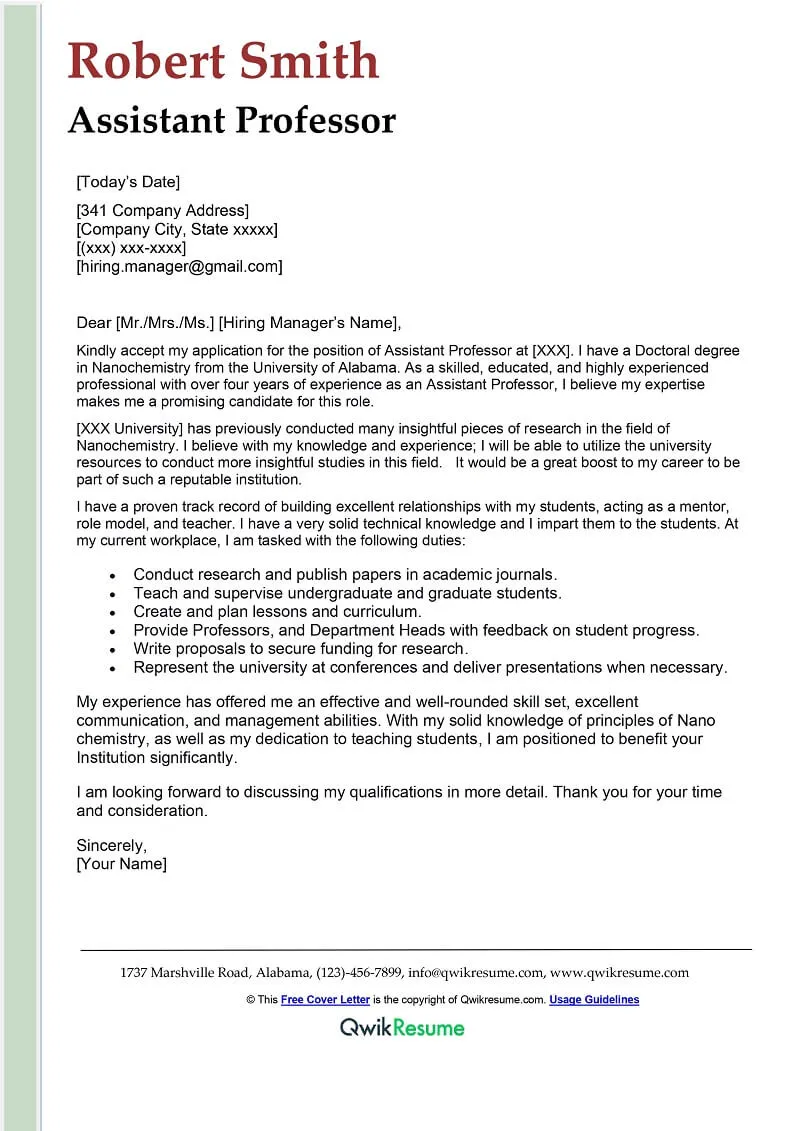
Thorough proofreading and careful formatting are crucial for making a positive impression. Errors in grammar and spelling can undermine your credibility and professionalism. Before submitting your letter, carefully review it for any typos, grammatical errors, and inconsistencies. Use a spell checker and grammar checker, but also read the letter aloud to catch any awkward phrasing or mistakes. Ensure your formatting is clean and easy to read, with consistent font choices, spacing, and margins. A well-formatted, error-free cover letter demonstrates your attention to detail and professionalism, making a strong impression on the hiring committee.
Ensuring Clarity and Conciseness
Clarity and conciseness are key to an effective faculty cover letter. Use clear and concise language to express your ideas. Avoid jargon and overly complex sentences that can make your letter difficult to understand. Focus on conveying the most important information in a straightforward manner. Each paragraph should have a clear purpose, and each sentence should contribute to the overall message. Keep your letter within the recommended length (typically one to two pages). A well-written cover letter is easy to read and immediately communicates your value to the hiring committee.
Formatting for Readability
Pay close attention to the formatting of your cover letter to ensure it is easy to read and visually appealing. Use a professional font such as Times New Roman or Arial, and ensure it is a readable size (typically 11 or 12 points). Use single spacing within paragraphs and double spacing between paragraphs. Maintain consistent margins (typically one inch on all sides). Use bullet points to highlight key information and make it easily scannable. Proper formatting enhances readability and allows the hiring committee to quickly grasp your key qualifications and accomplishments. A clean, well-formatted cover letter will make a favorable impression.
Sample Faculty Cover Letter: A Detailed Example
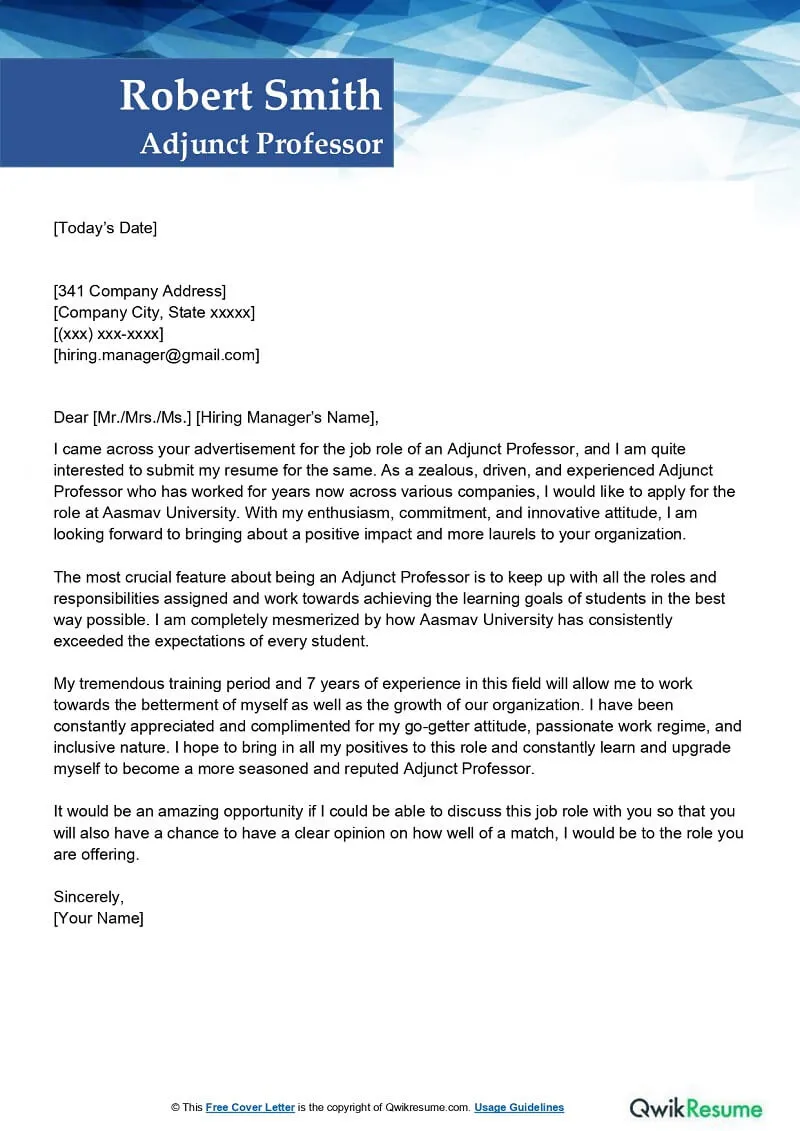
The following sample cover letter provides a detailed example of how to structure and present your qualifications for a faculty position. This example incorporates the key components discussed earlier, including a strong opening, detailed descriptions of research and teaching experience, and a persuasive closing. While this sample serves as a valuable guide, it is crucial to tailor your cover letter to the specific requirements and expectations of each job application. Personalize your letter to reflect your unique experiences and qualifications, ensuring it showcases your suitability for the position. Use this sample as a foundation to create a compelling and effective cover letter.
Header and Contact Information in Sample
The header includes your full name, address, phone number, and email address. Ensure this information is placed at the top of your letter, either on the left or right side. The date should also be included to show when the letter was written. A well-formatted header is crucial for professional presentation. Ensure your contact information is accurate.
Address to the Hiring Committee in Sample
Start by addressing the letter to the specific person, if known. If not, use “Dear Search Committee”. It’s helpful to find the name of the committee chair if possible, which shows initiative. Use a respectful and formal tone to convey professionalism. Ensure this is accurate and consistent with university standards.
Opening Paragraph Example
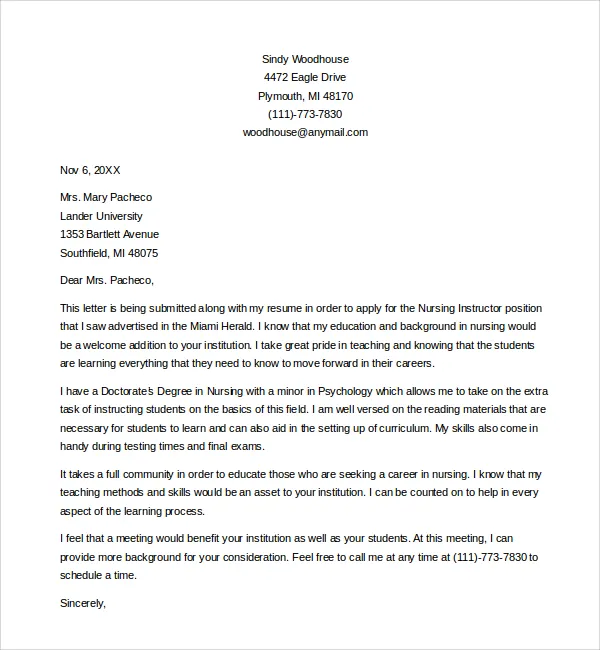
The opening paragraph should immediately state the position and where you found the job posting. Briefly mention your interest in the role. Highlight your enthusiasm for the department or the university. This should capture the reader’s attention immediately, showing why you are applying and why you want the job.
Research and Publication Example
Showcase your research accomplishments, including your primary areas of research. Emphasize key publications, grants, and any awards you have received. Discuss how your research interests align with the department’s goals, and what contributions you can make to the university. Clearly state how your research will be a benefit to the university, including any potential collaborations.
Teaching Experience Example
Discuss your teaching experience, including the courses taught and the student level. Highlight any innovative teaching methods or positive feedback from students. Mention your teaching philosophy and how you create engaging learning environments. Make sure you emphasize your dedication to student success.
Skills and Qualifications Example
List skills related to the job, which should come directly from the job description. Give specific examples that prove your qualifications and how you have used these skills. It’s important to tailor this section to the job and show the hiring committee you fit their needs.
Closing Paragraph Example
In the closing paragraph, express enthusiasm for the role and your eagerness to discuss your qualifications. Thank the committee for their time and consideration. Include a call to action, such as offering to provide additional information or stating your availability for an interview. End with a professional closing, such as “Sincerely” or “Best regards.”
Final Review and Submission of Your Cover Letter
Before submitting your faculty cover letter, conduct a thorough review to ensure it is polished and professional. Proofread it carefully for any errors in grammar, spelling, and punctuation. Verify that your contact information is accurate and up-to-date. Ensure the formatting is consistent and easy to read. Make sure your cover letter aligns with the specific requirements of the job description and the university’s mission. Submit your cover letter along with your CV and any other required materials. A well-prepared submission demonstrates your attention to detail and increases your chances of securing an interview. Good luck with your application!
